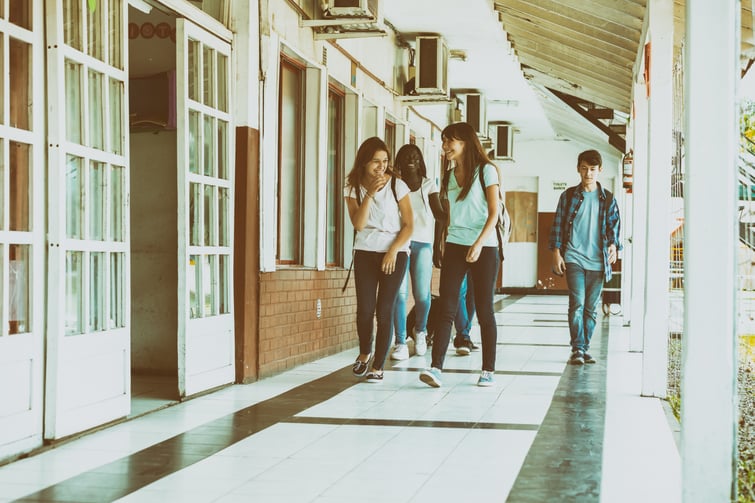The unique, sensitive toll that has befallen the country urgently begs us to come up with non-traditional ways to address youth violence. Current methods of treatment are clearly not enough—we need to find new ways to prevent school shootings, which starts with addressing the behaviors and risk factors that influence youth violence.
How to find new ways to prevent school shootings? Holistic programs can help communities address violence and reduce risks
Every two weeks, on average, America suffers from the physical and emotional impact of a school shooting. After the dust settles, we are left with the pressing question—what now? The unique, sensitive toll that has befallen the country urgently begs us to come up with non-traditional ways to address youth violence. Current methods of treatment are clearly not enough—we need to find new ways to prevent school shootings, which starts with addressing the behaviors and risk factors that influence youth violence.
Many young people believe violence is commonplace in the hallways. According to a student at Hoover, a high school near Birmingham, Alabama, “It’s just so normal. There are fights all the time. You keep your head low, a teacher comes out and asks us to knock it off, and the bell rings. It’s no big deal.”
However, violence in the hallways should be a big deal, and the fact that it is not highlights how pervasive it has become. In their quest for alternative ways to prevent school shootings, communities should take a step back and consider how to address the common occurrence of youth violence more generally. Approaches should be broad and holistic: focused not just on one behavior or risk factor, but considering the entire ecology of a young person’s life.
This is the approach that Multisystemic Therapy (MST) takes when treating delinquent and violent youth. MST works not just with the youth, but with all aspects of their life—school, family, peers, and community—to address causes of anti-social and violent behavior. The intensive, in-home therapy offered by MST can help reduce the risk factors that may lead to school shootings, and communities should consider the benefits of this approach when seeking ways to prevent school shootings.
Related: Youth Mental Health Treatment Can Help Communities Stop School Shootings
MST addresses risk factors that may lead to school shootings
There are several ways that MST addresses risk factors that may lead to school shootings. First and foremost, MST functions across various domains of a young person’s life to seek, identify, and understand warning signs of violence. There is no alternative to a holistic approach to care. If there are cracks in support or blind spots in treatment, there is too much room for error. Secondly, MST reduces anti-social behaviors to create a better environment that encourages students to prosper in school, and to improve engagement with their community. After treatment, 86% of youth that receive MST are in school or working, which helps reduce the risk of delinquent or violent behavior.
Additionally, MST includes the family as an essential component to its treatment plan. MST professionals know how to talk to family members, and give them tools to recognize violent risk behaviors and handle sensitive situations in the home. This creates a positive ripple effect, as seen by the 55% decrease in sibling felony arrest in families treated with MST. MST doesn’t just take care of one person—it takes care of a support network.
What’s more, MST experts understand the problem-solving skills and emotional regulation needed to reduce situations that may lead to violence. The method of transferring these skills is the MST trademark, and a large part of the reason why the model is so effective.
MST's positive impact can create lasting change
The long-lasting impact of MST is important for communities looking for ways to prevent school shootings. We do not want to keep kids out of jail just long enough for them to graduate high school and then fall into trouble with the law again. There are plenty of alternatives to MST that just keep juvenile offenders treading above water for some time. MST, on the other hand, makes sure juvenile offenders learn how to swim. We don’t want our system to fail in the long-run, and the evidence suggests that the MST treatment model is the right move for communities looking to create sustainable change.
Studies have demonstrated that MST’s results last for decades. One study found that youth who received MST had 75% fewer violent felony arrests over 22 years following treatment. There is a large body of evidence that demonstrates that MST can create change to make communities safer—and that change will subsist over time.
MST aligns with broader views on how to address violence
Dr. Michael Karch is a world-renowned surgeon with a specialty in mass casualty trauma. Speaking on the consequences of school shootings, he highlighted the importance of “forming more complex interpersonal interactions, reconnecting, talking to friends and family”, saying that these actions are important in maintaining resilience in today’s climate.
MST helps facilitate the previously mentioned interpersonal interactions by working within the whole ecology of the youth, and teaching skills that are critical for healthy relationship development such as communication and conflict resolution. The treatment approach sets the stage for long-lasting behavioral change that can contribute to safer families and communities.
When we use MST to treat youth in the home, work with communities and families to identify possible warning signs, and encourage positive relationships, there is hope that we can reduce the risk factors leading to violence. Knowing there is no singular solution to the problem, communities can and should consider alternative ways to prevent school shootings, and MST is a proven and practical first step to prevent troubled youth from escalating to violence.
For more information about factors related to school safety, visit our School Safety Resources page by clicking here.
Also, download our full white paper, "Five Ways MST Addresses Risks That Can Lead to School Shootings" by clicking the button below:



